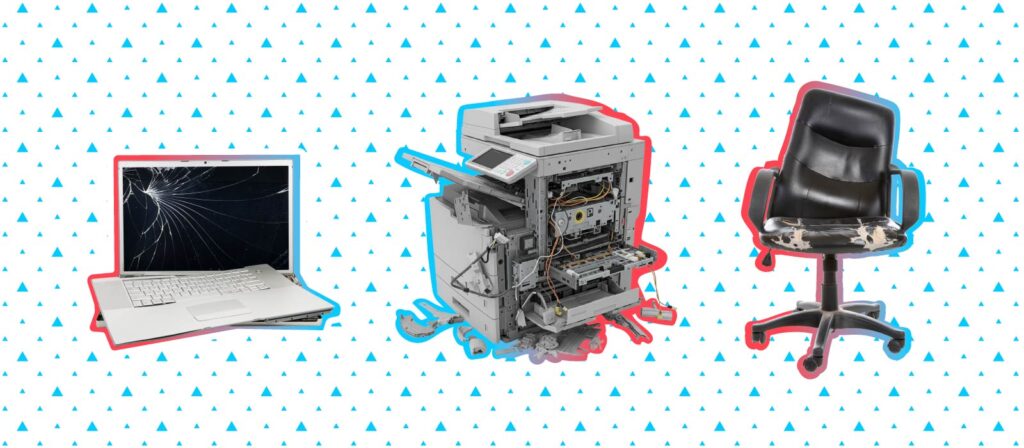Workplace waste management: why you need a sustainability strategy

Reduction In Motion’s Bill Griffith breaks down the elements of a properly functioning waste management system and how it can save money for businesses.
There are many rules and regulations surrounding waste disposal, and with more likely on the horizon, businesses are often left scrambling to manage new mandates, let alone find the true value in how they deal with trash. Generally speaking, they know it’s something they should be doing but sometimes struggle to understand the cost savings and cause and affect aspects.
That’s where someone like Bill Griffith comes in. A sustainability expert with 30 years of experience in the industry, Griffith leads Reduction In Motion, a sustainability consulting firm that specializes in waste management solutions. They help organizations implement waste management strategies that are designed for both efficiency and longevity.
What is the link between a properly functioning waste management system and sustainability? How does one affect the other in an office space, for example?
Griffith: In an office environment, if the business is going to do a waste diversion program or recycling program — that’s great. That said, if they’re not going to buy back office paper that has recycled content in it, they’re defeating the purpose.
In order for the cycle to work fluidly, you need to invest your dollars at the front-end into buying materials that have recovered product in them. This creates a market and the knowledge that there’s someone who wants to recover them when they’re disposed of.
I think that’s where a lot of businesses miss the mark. They don’t do that simple act. Many times, recycled paper is the same price as non-recycled paper. It might fluctuate in pricing when you get different grades, but it should be the same price and it just takes a little effort to look for it.

What are some of the most common misconceptions about waste management that clients may have? How do you help them understand it on a deeper level that affects their business?
Griffith: The biggest misconception for customers is that they don’t fully understand the expense of disposing their waste. What I mean by that is constantly reviewing invoices to understand the cost of disposal, cost for rental equipment, fuel environmental surcharges, energy surcharges. Those all factor into building the expenses behind starting a recycling program and what the true cost of that program will be.
People’s initial assessment is generally “it’s too much energy, it’s too much work, it’s not worth it.” They go off the perception that a lot of people have which is that it’s more expensive to recycle. Sometimes is it, but living in big cities that now have plastic bag bans, styrofoam bans, plastic straw bans, and so on — regulations are just going to get more stringent.
What we’ve always said to businesses is that it’s important to start the process on your own program before a mandate comes down so that when the mandate comes down, the process is already established. You can speed it up when that mandate comes, but you can start to do it slowly when the mandate is not in place yet.
A lot of people just don’t understand how much it costs to dispose or recycle waste. For us, we always help people by starting with what we call a waste baseline assessment. We analyze 12 months of the organization’s actual expenses and figure out what those cost-per-pounds are for managing each waste stream.
How much do they generate in volume? How much do they generate in cost? What’s the cost to manage it on the site? What type of collection containers do you have in place? What type of communication and stewardship do you have? All that should be factored in when an organization is assessing whether a program is right for them. We always believe there needs to be a strong business case in order to do it. If there’s not a strong business case, most of the time it’s not going to be a viable or sustainable program. Nine times out of ten, however, there’s always a business case — it’s just about how you look at it.

What kind of impact can an improper waste management system have on an organization’s bottom line? How much money could they be losing as a result?
Griffith: That’s really going to be dependent on the municipality that they’re in. If you’re in an office building, on the low end, recovery and recycling should help you save about 50 percent. On the higher end, it should be about 75 percent. The majority of that material being paper or fiber because offices, even though predominantly on computers, still generate a lot of paper.
Where I see organizations getting exposed is when they’re improperly disposing of things like electronics, lightbulbs, and batteries. These things fall under universal waste, which is a subset of hazardous waste. Depending on if they get caught improperly disposing of this material, that could cost them in fines.
We see it here in D.C., there’s a pretty strict recycling program that’s enforced. If you’re sending out your municipal waste or trash and there’s a lot of recyclables in there, they’ll fine you for that load. More and more municipalities such as New York are now doing that because they’re under mandates to reduce landfill usage. They don’t want to send something to the landfill that shouldn’t be going there. I think the biggest exposure is being fined, but every county is different on how they enforce rules.

And on the other hand, what kind of cost savings are there to be found in properly managed and ethical waste disposal?
Griffith: I would say the average facility will save about 20-35 percent initially. A baseline waste assessment not only identifies current waste volumes and costs-per-pound, but it also identifies if the current waste equipment types and associated service fees are both reasonable and cost-effective. There are inefficiencies in nearly all waste programs, we know where to look for them to start saving you money right away. You can take those first-year savings, which are great, but you want to sustain those savings. Understanding how much you generate and how much you spend is critical because you need to set up that dashboard to understand the impact on your expenditure when you’re signing a new agreement.
Most people just look at the bottom line and see x-amount of dollars this year and last year and that adds up to three percent. Well, where’d the three percent come from? Was it the cost of living? An increase in materials? Haulers are also famous for putting more and more varying fees inside their invoices. If you don’t have a strong advocate like us to monitor that and make you aware of that — you just accept those charges and they become the norm.

How do you build a workplace waste management system that is effective over a long-term period and not just a quick fix solution?
Griffith: That’s really why we founded our company in 2002. We are a sustainability consulting firm specializing in waste minimization and waste solution strategies. What makes us different from other consulting firms is that we put our people in place to help run and manage the program. You’re exactly right. You come in, roll out a new program, and everyone is excited. Six months later, a new initiative is out and the current initiative has been squashed.
For us, we follow a lean process that is the same steps no matter what we do. We always start with a waste baseline assessment, so you know where you’ve started. Then we do a documented plan, which is a report that states your potential savings and benefits. Once that document is approved, we educate and communicate by telling everyone what’s coming, either in-person or through educational sessions. In an office environment, it could be in a morning huddle or lunch period. Once we tell everybody, then we deploy and put out the changes. After that, we monitor and track and that’s where we’re different from other consultants. We’re going to roll out a program and then come back on a regular basis and keep checking in.
If we’re doing an office building and not going to roll out 60 floors at once, we’re going to roll out chunks and reassess and revaluate. Then we go to the next floor with our lessons learned and re-apply those right from our education deployment and keep going back.
I believe that’s what makes the program work. If you only fund it and fuel it for the first six months, it’s actually a waste of money. We’re not the difference of why it works, you need somebody that’s going to be an advocate and voice for each person at the table, including waste generators and waste handlers. There has to be an advocate for every person in the process to make sure it’s all working together.
Find out more about how Reduction In Motion can help your organization with its waste disposal needs at their website.
How do you think a properly functioning waste management system can impact business? Join the conversation and leave us a comment below.
Photos: rawpixel.com, Juan Pablo Arenas, rawpixel.com, shutter stock




